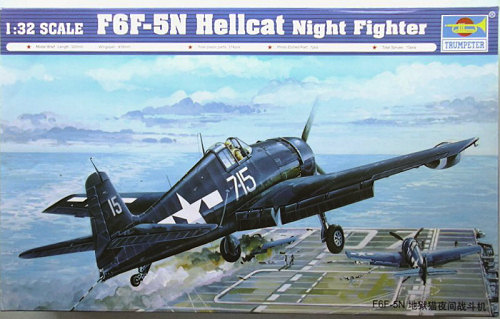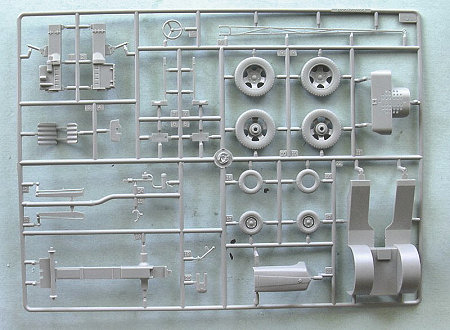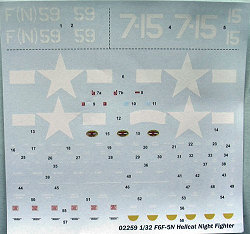
| KIT: | Trumpeter 1/32 F6F-5N 'Hellcat' |
| KIT #: | 22.59 |
| PRICE: | $89.95 |
| DECALS: | two options |
| REVIEWER: | Tom Cleaver |
| NOTES: |

| HISTORY |
The F6F‑3/5 Hellcat is the most successful naval fighter series ever built. With pilots of moderate training levels, the airplane could more than hold its own against its opponents, while it was tractable enough that the same moderately‑trained pilot could bring a damaged one back and get aboard his carrier, a point of no small importance in naval warfare. It is the only fighter of the Second World War to remain essentially unchanged in basic design from its introduction to service to its post‑war withdrawal, with the main difference between the two production variants being engine power.
The Myth of the Hellcat:
To straighten out the myth of the airplane, the Hellcat was not produced "in answer" to the Japanese Zero, which would be its major wartime opponent; it would have been impossible to designan airplane starting in 1942 (following the discovery of the Zero in the Aleutians that August) that would have had any hope of getting into production in the required timescale. The Hellcat was already in preliminary design stages well before the outbreak of the Pacific War, and first flew about the time of the Battle of Midway. What was indeed fortunate was that both Grumman and the "Fighter Desk" of the U.S. Navy's Bureau of Aeronautics had paid attention to what was going on in Europe with regards to air combat. They guessed right in giving the Hellcat the biggest wing of any Second World War fighter for maneuverability, and thelargest ammunition capacity, to improve its ability as a fleet defense fighter. They were fortunate that the airframe was amenable to initial change from the underpowered R‑2600 to the far‑superior R‑2800, the finest radial piston engine ever built. With this engine, the airplane had sufficient power to outfly its opposition.
The Hellcat first entered combat in the fall of 1943, as the Navy was beginning the Central Pacific Offensive, with squadrons based aboard both the big "Essex" class fleet carriers, and the "Independence" class light carriers which were based on cruiser hulls. The U.S. Navy was the only air force of the Second World War to insure its fighter pilots went into combat knowing what to do both with their airplanes and their weapons. With this superior gunnery training, many Hellcat pilots became an “ace in a day" in the swirling air battles that began over Truk in early 1944, and then moved on across the Central Pacific with the invasions of the Marshalls and Marianas later that year.
Striking across the breadth of the Pacific against Okinawa, Formosa, Indochina and the Philippines during the summer and fall of 1944, Hellcats shot down everything they ran across. From their first introduction into combat in the summer of 1943 through August 15, 1945, U.S. Navy Hellcats shot down over 5,000 enemy aircraft, and over 300 Hellcat pilots achieved ace status while flying the airplane. Truly, it was an "ace maker."
| THE KIT |
 The
other 1/32 Hellcat I am aware of is the Hasegawa kit first released in the late
1970s. This kit effectively makes that kit obsolete on any point other than
price.
The
other 1/32 Hellcat I am aware of is the Hasegawa kit first released in the late
1970s. This kit effectively makes that kit obsolete on any point other than
price.
The kit provides superb detail, with fully-detailed engine, accessories, and radio gear within the fuselage that can be seen if a modeler chooses to “open up” the model. The gunbays are fully detailed and the main gear wells have the most detail of any Hellcat in any scale. The cowling is the right shape with the definite “chin” that other manufacturers have missed.
Trumpeter has continued their policy with US Navy aircraft of providing a model that can be built with its wings folded. Unlike either the F4F Wildcat or the TBF Avenger kits, however, Trumpeter has come up with a design for this kit that provides parts that will allow the wing to have sufficient strength either folded or spread to stay in its correct position and not be fragile. The system chosen is somewhat similar to that used by Tamiya for their Corsair and Swordfish, with spars that go deep into the separate wing areas to provide sufficient strength.
The kit can be built as a “straight” F5F-5, since the radome and 20mm cannon are separate and the instrument panel for the day fighter is provided.
For once, Trumpeter has gotten the decals “good enough” that they can be used. The “white only” US national insignia are the right proportions. The kit provides markings for an F6F-5 from VMF(N)-531 that I think was flown by Bruce Porter, and one from VF(N)-107. There is not much in the way of colorful markings for F6F-5s, but the Marine night fighter does have a nekkid lady on the cowling that is a good decal. One hopes that the aftermarket people will come up with things like the FAA Hellcat II in BPF markings that shot down the last Japanese airplane of World War II, and other interesting markings like the French Aeronavale.
The kit also provides a 1/32 scale tractor or the type used on Navy carriers during the war, which will useful in creating a diorama.
Now then, let’s get into the kit’s Big Problem, which fortunately has an Easy Solution:
After writing the above review, I did a more extensive study of the Trumpeter
Hellcat, and I have to report that there is something wrong about the
kit. Whether this is a “deal breaker” is for the modeler to decide, but here it
is: somehow, Trumpeter has gotten the cross section of the fuselage around the
cockpit and for about one-third of the distance from the cockpit to the vertical
fin wrong. It is too fat, too wide, and the result is that in this area of upper
fuselage just aft of the cockpit the sides of the fuselage curve outwards in a
way that is very “un-Hellcat-like.” In side profile the model looks all right,
but in head-on profile, the cross section is completely wrong, as it is not the
flat-sided upper fuselage associated with the Hellcat. This makes it look
“squat” in a way the Hellcat just doesn’t do. I have reviewed every photo I
have of Hellcats, including some photos I have taken of the two Hellcats out at
Chino, and from the 4 o’clock or 8 o’clock positions, this “fatness” that can be
so clearly  seen in the model from those angles is nowhere to be seen on the real
thing.
seen in the model from those angles is nowhere to be seen on the real
thing.
Fortunately, it turns out this is not “unfixably wrong,” as such a mistake usually is with a kit.
I simply bent and re-shaped the fuselage in the “bulged” area. This is possible since the plastic is soft. Next, one needs to sand the sides of the rear cockpit bulkheads so they have “straight” sides. You will need to “test fit” these to the fuselage after you have re-shaped it.
Finally, the canopy and windshield need re-shaping. I dipped each in just-below-boiling hot water and then “pinched” them to the proper cross-section, then ran them under cold water for a minute to “freeze” the change.
Past that, there are no problems in assembly that I have found, other than some seam-filling for the cockpit and the fuselage just aft of the cockpit to make up for the changes in cross-section shape.
For
those modelers who may be considering doing the VMF(N)-541 airplane, which is by
far the more colorful of the options
 with its “nekkid lady” on the cowling, I
have found photos of this airplane in “Night Wings,” the Squadron-Signal book
about Marine night fighter squadrons, that shows this was an early F5F-5, with
the rear windows, and an armament of six machine guns. It’s easy to modify the
kit to this standard, since the rear windows are molded in on the inside of the
fuselage and six machine gun barrels are provided, so you do not use the 20mm
cannon. Additionally, while this airplane did have the bomb racks, it did not
have the rocket rails. You will need to trim the rear forward bulkhead to allow
the cutouts for the windows. The additional nice thing about this airplane as a
subject matter is that by the time the nose art was applied in May 1945, the
airplane had been in the Central Pacific since October 1944, so it does indeed
have a sun-faded and salt-air corroded Glossy Sea Blue finish, with lots of
exhaust staining. This means your nice big 1/32 model doesn’t have to be a borrrrinnng single color. I would suggest you look at my review last year of
the Trumpeter SBD-2 for how to get a sun-faded, salt-air corroded finish.
Remember, even in this environment, GSB has only a subtle reaction.
with its “nekkid lady” on the cowling, I
have found photos of this airplane in “Night Wings,” the Squadron-Signal book
about Marine night fighter squadrons, that shows this was an early F5F-5, with
the rear windows, and an armament of six machine guns. It’s easy to modify the
kit to this standard, since the rear windows are molded in on the inside of the
fuselage and six machine gun barrels are provided, so you do not use the 20mm
cannon. Additionally, while this airplane did have the bomb racks, it did not
have the rocket rails. You will need to trim the rear forward bulkhead to allow
the cutouts for the windows. The additional nice thing about this airplane as a
subject matter is that by the time the nose art was applied in May 1945, the
airplane had been in the Central Pacific since October 1944, so it does indeed
have a sun-faded and salt-air corroded Glossy Sea Blue finish, with lots of
exhaust staining. This means your nice big 1/32 model doesn’t have to be a borrrrinnng single color. I would suggest you look at my review last year of
the Trumpeter SBD-2 for how to get a sun-faded, salt-air corroded finish.
Remember, even in this environment, GSB has only a subtle reaction.
| CONCLUSIONS |
Yes, Trumpeter should have “gotten it right” from the beginning for a shape like the Hellcat, but with only a moderate application of “some modeling skill required,” the result will be a very good model.
Thanks to Stevens International for the review kit.
August 2007
If you would like your product reviewed fairly and quickly by a site that has nearly 400,000 visitors a month, please contact me or see other details in the Note to Contributors.